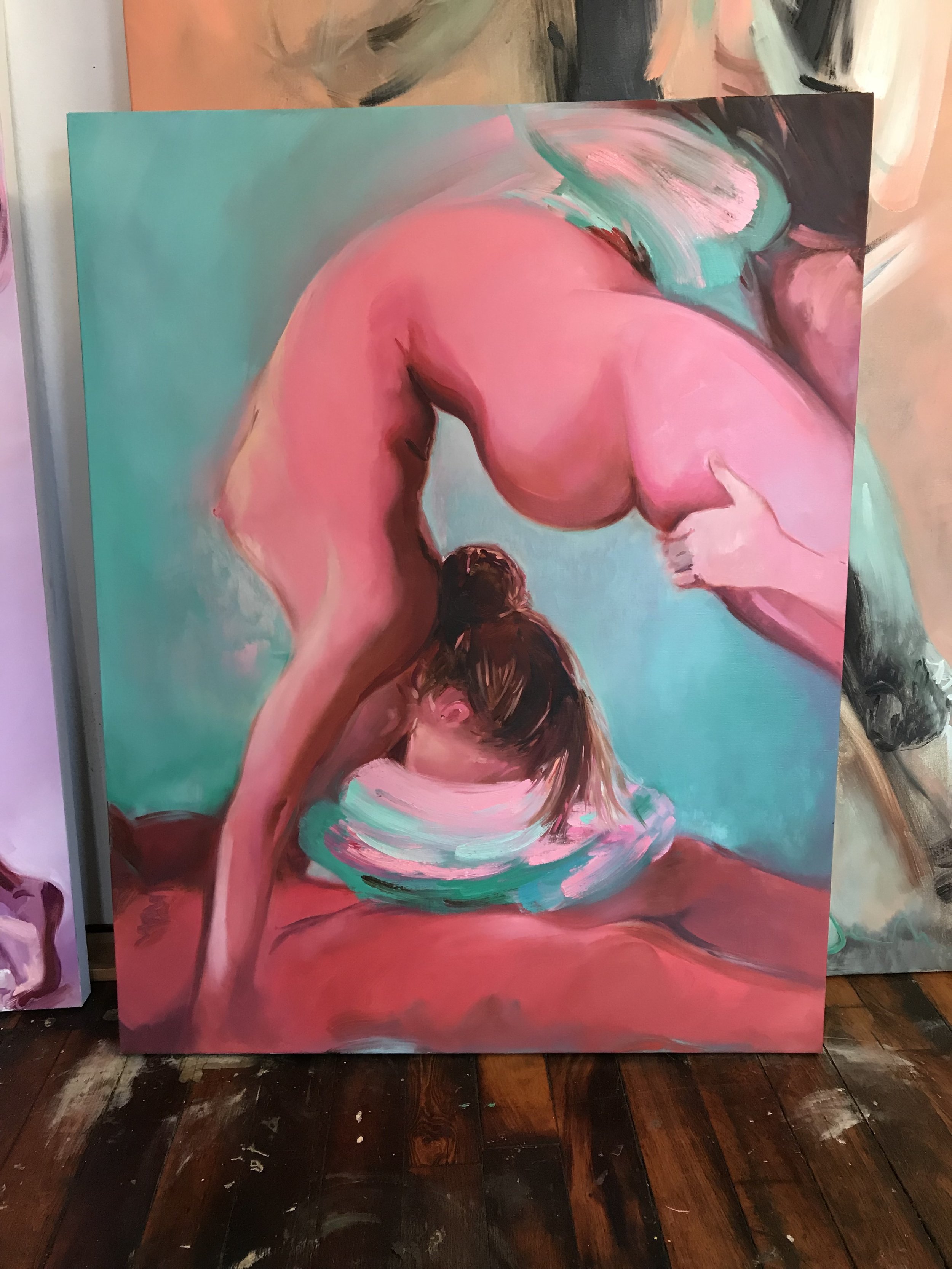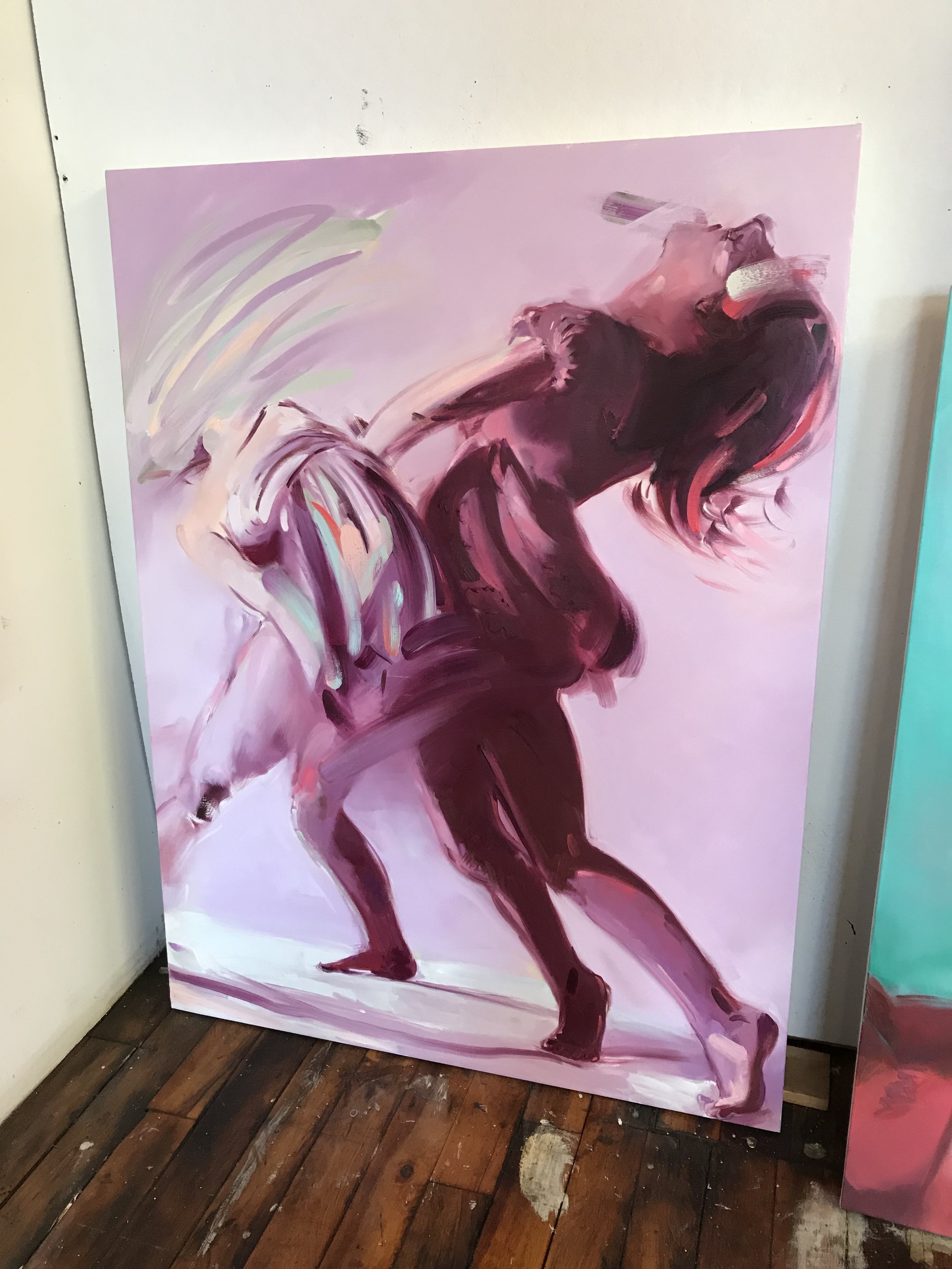Susan Murie in her home studio. Image courtesy of the artist.
Abigail Ogilvy Gallery is proud to showcase the work of Susan Murie, a local, contemporary artist working primarily with cyanotypes. We recently had a great conversation with Murie about her artwork, her influences and inspiration, and the incorporation of botanical topics and processes in her work.
Abigail Ogilvy Gallery (AOG): First, can you briefly describe the process of cyanotypes?
Susan Murie (SM): Cyanotype is a photographic process invented by astronomer, Sir John Herschel in 1842. It is also known as blueprint. It uses light-sensitive iron salts produced by brushing solutions of ferric ammonium citrate and potassium ferricyanide onto a porous surface, such as paper, dried in the dark. The solution is UV light sensitive and exposure of the image is done with sunlight or other UV light sources. I select fine art papers and coat them with the solution and use the sun for exposure. After exposure the print is washed in water to clear away any remaining solution and then hung to dry.
AOG: What drew you to cyanotypes as a medium?
SM: I’ve been working with photography since college in various forms though the years - black and white, hand colored and large, abstract color prints and artist’s books. About 12 years ago I read an article in a cooking magazine about a small restaurant in Georgia that featured a whole wall of botanical cyanotypes by photographer Rinne Allen. In that moment I knew I wanted to explore the medium. And I did! It continues to fascinate me.
Susan Murie, “Ancestral Map 2,” Cyanotype on paper, 45 x 30 in., $2500
AOG: In your statement, you note the uncertainty of the outcome with this medium. Was this something you were able to quickly embrace, or was it more of a learned process to work with this uncertainty?
SM: In the beginning, as I was learning how to make cyanotypes, I wanted to master the process. I made many, many prints using pre-coated paper, later switching to coating my own paper. Once I understood how it worked, I learned to welcome and work with the unpredictable nature of the medium. I’ve come to understand that the uncertainty works well with the theme of ephemera in my work. Seasons, paper, wind, clouds can all have an impact on the resulting prints.
AOG: How has your vision and process changed over time? Was there a pivotal moment for you?
SM: Yes, there was a distinct time when my work shifted. Until a few years ago, I was making work with actual plants and objects applied right to the paper and exposed in the sun. I began to want to make larger prints and have objects out of scale. I literally woke up one morning and decided, from that point on, I would photograph all my subjects and print from negatives. I knew I could produce large negatives and play with scale and most importantly, lighting, to apply more focus in my work. It also enabled me to work much larger which changed how I work and the dynamic of my finished pieces.
AOG: What are the similarities you’ve found between working as a gardener and as an artist?
SM: Both are creative mediums but also take a lot of hard work, including physical, that the casual viewer may not fully realize. For my work with cyanotypes, the obvious connections to gardening are the use of sunlight and water.
AOG: Do you have any advice for artists who work botanically in terms of how they can allow it to inform their artistic practice?
SM: Get out in wild nature as much as you can. It is a very different thing to flowers in a vase.
AOG: Who are your mentors in the arts, and how have they shaped the way you approach your work?
Susan Murie, Aurelia. Cyanotypes on gampi paper assembled on Japanese metallic paper. 31 x 21 in.
SM: I was fortunate to be selected to be an artist in the the Community Supported Art initiative in Cambridge, MA. This unique program gave us a grant to produce multiples which would be sold in the form of an art share, much like a farm CSA. We were also given professional seminars to help us with the business and development side of being an artist. The program provided opportunities to exhibit and talk about our work with the public. There was also that community, again, which I loved. All the artists in our cohort are inspiring to me and I love to continue to stay in touch and see what they are making. Through the program local arts administrators became mentors and their hard work provided valuable opportunities for growth. This program really mattered to me and the work I am making now. We need that kind of support!
AOG: How long have you been an artist, and what were your earlier inspirations or influences that led you to become an artist?
SM: Like many artists I would say “all my life”! The desire to make art and also be with other artists just started at a young age and never stopped. When I was in elementary school my absolute favorite thing to do was make art in the summer with friends at our picnic table. I distinctly remember that I wanted that to never end. When I got older I found a group of artists working together in high school in the form of theater and that was my thing for many years. I picked up photography in high school as well and when I got to college, discovered there was darkroom in the basement of my dorm. A friend showed me how to make prints and that was the beginning. I also took drawing, sculpture and art history outside of the demanding course work and schedule of a theater major. I was drawn to visual art but didn’t know yet how that would manifest for me. I eventually left theater and went into filmmaking and video, all the while still making photographs. Lots of transitions, always making, seeking company with other artists and now here I am. I have been and am inspired by fellow artists in many mediums. I love live theater, dance and music. I go to see as much art as I can and be open to new ideas, media and points of view.
Susan Murie, Downrush. Cyanotype on paper with colored pencil. 30 x 22 in.
AOG: Any advice for the next generation of artists?
SM: Seek out the community and companionship of other artists where you can be accepted for who you are and what you do. Know that your value to your community and society at large is real. It can be a struggle here in the US where “productivity” is all. Taking time to reflect, read, engage in conversation are all of value. Let yourself partake in slow life. Be curious.
———
Visit Susan Murie’s artist page for images and available artwork: https://www.abigailogilvy.com/susan-murie




